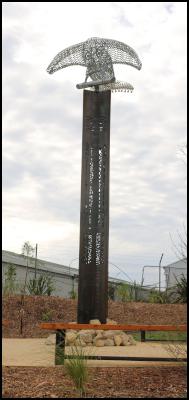Ruru watching over Kohupatiki
Ruru watching over Kohupatiki

A ruru (morepork), beautifully hand-crafted from galvanised steel atop a column of weathering steel, now watches over Kohupatiki Marae and the awa of its people, the Ngaruroro Mokotuararo ki Rangatira/Clive River.
Historical landmarks of mana must not be forgotten, says Arconnehi Paipper (Aki), the woman behind the dramatic pou that has been erected on the cycleway in Whakatu.
The Pou marks the spot where the pre-European fortified Pa Otanenuiarangi stood. “The pou honours the history of where we came from which is inseparable from who we are today.”
In the early 1800s the pa was a stronghold, protected from invaders by a palisade of kahikatea (white pine), one of the favoured habitat of the ruru; New Zealand’s native owl.
The design of the pou reflects the relationship between the river and the people; the pebbles (the substrate), the flow of the river, the bird life and endemic fish species that were plentiful, and the waka used for travel both inland and out to the bay. “The entire pou reminds us of the protection the kahikatea provided through its interlocking root system that was never breached,” says Ms Paipper.
“We were a very rich people in that our food supply that came from the river and the land was abundant. Kohupatiki was famous for the food we fed our visitors from the awa, along with crops grown right here.
“The awa was a waka highway; we connected with marae all along it. When the European came we used the river to trade with the whalers and sealers.”
The making of the pou was a collaboration between Kohupatiki, artists, HB Wool Scourers, and both the Hastings District Council and Hawke’s Bay Regional Council.”
The project had not between without challenges and sadness.
In the first instance a totara of the size and quality needed could not be found. Local artist and friend William Jamieson suggested that steel would be a medium of a weight that would honour the korero. He drew the design but then passed away before the work could be completed.
“At his tangi, held at Kohupatiki Marae, his friends, artists I did not know but who were connected to each other, said they would complete the pou. Jacob Scott, Rick Terstappen and my nephew Mitch Matheson stepped forward, and my niece Ani McGuire, a graphic artist completed the team. Their input is reflected in what we have today.
“Their friendship was what the undertaking needed for the vision to be completed.”
Across at Kohupatiki a sculpture gifted by William’s family stands on the awa reflecting his love of waka ama and the awa.
The pou, while a standalone project, is inextricably linked to the work that is going into restoring the health of the Karamu/ Ngaruroro/Clive rivers. Eight years of clearing weeds and planting natives along the banks of the river are showing strong results, and the long term outcome of a project this year to dredge weed and sediment from a stretch of the river is being closely watched. The work is part of Operation Patiki, launched back in 2010.
“We required a new plan to halt the degradation, the old plan wasn’t working; we needed a change of course for outstanding biodiversity and ecology. Give the land, rivers, lakes and streams a chance, and we will see an economic boon for all,” said Ms Paipper.
As well as marking a site of significance, the pou is now a beautiful place of reflection, says Ms Paipper. “The landscaped surroundings are edged by seats, a story board tells the korero, birds sing, and the awa is ever present.”
Access to the Pou is along the cycleway leading from Essex Crescent Reserve in Whakatu.
ENDS


 Gordon Campbell: On The History Of Doo Wop Music
Gordon Campbell: On The History Of Doo Wop Music Environmental Defence Society: Regulatory Standards Bill Should Be Stopped In Its Tracks
Environmental Defence Society: Regulatory Standards Bill Should Be Stopped In Its Tracks NZ Police: A Minute's Silence And Livestream Of Funeral Service For Senior Sergeant Lyn Fleming
NZ Police: A Minute's Silence And Livestream Of Funeral Service For Senior Sergeant Lyn Fleming Socialist Equality Group: Foreign Interference Bill Prepares New Attacks On Democratic Rights
Socialist Equality Group: Foreign Interference Bill Prepares New Attacks On Democratic Rights Melanie Nelson: Act Now On The Proposed Regulatory Standards Bill
Melanie Nelson: Act Now On The Proposed Regulatory Standards Bill Climate Justice Taranaki: The Bill For Individualism, Corporations And Neoliberalism
Climate Justice Taranaki: The Bill For Individualism, Corporations And Neoliberalism Ministry For Culture & Heritage: New Zealand Flag Half-Masting To Mark The Funeral Of Senior Sergeant Lyn Fleming, NZ Police
Ministry For Culture & Heritage: New Zealand Flag Half-Masting To Mark The Funeral Of Senior Sergeant Lyn Fleming, NZ Police


